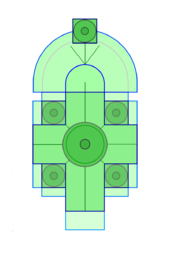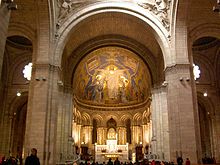Sacré-Coeur de Montmartre
The Basilica minor Sacré-Cœur de Montmartre [ ˌsakʀeˈkœʀ ] (Basilica of the Sacred Heart in Montmartre) is a Roman Catholic pilgrimage church built in the neo-Byzantine style on Montmartre in the 18th arrondissement of Paris , which is dedicated to the Sacred Heart of Jesus .
architecture
The construction of the historicist church was started in 1875 by the architect Paul Abadie , who had prevailed against 78 competitors in a competition, and was completed in 1914. The church consecration took place after the end of the First World War in 1919. Paul Abadie's design was clearly inspired by the architecture of Roman-Byzantine churches such as Hagia Sophia in Istanbul and St. Mark's Basilica in Venice as well as the Périgueux Cathedral , which he had restored. Sacré-Cœur was later to become a model for other sacred buildings of the 20th century, for example the basilica Sainte-Thérèse in Lisieux . Abadie died in 1884 when construction had only just begun. He was followed by six architects in the construction management until completion. Architecturally, the church is not a basilica , but a cross-domed church .
Sacré-Cœur was put together from Château-Landon stones, a frost-resistant travertine from the town of the same name in what is now the Seine-et-Marne department , which gives off its calcite through the weather and thus takes on a chalk-like white over time. The foundations reach 33 meters into the ground to prevent the church from sinking into the loamy subsoil. The church itself measures 85 by 35 meters and is 83 meters high. The large dome alone is 55 meters high, from it you can see up to 40 km in good weather conditions.
The iconography of the basilica is national: the three-arched main portal is supported by equestrian statues of the national saints Joan of Arc and Louis IX. flanked by Hippolyte Lefèbvre .
In the apse of the basilica is the mosaic of the Sacred Heart by Luc-Olivier Merson (completed in 1922), which is one of the largest mosaics in the world at 475 m² . It shows Jesus with a flaming heart surrounded by thorns and arms outstretched.
For a long time, the architecture of Sacré-Cœur was rated negatively in specialist and travel literature. In a picture book from 1974 it says:
"When you approach and reach the forecourt, when you enter the interior, you cannot put up with the accumulation of meaningless structures, the glorious, disproportionate domes, the indestructible ugliness of the sculptures and mosaics and even less with the coldness of the pale material, which will never take on a patina, this robust stone from Château-Landon which, contrary to expectations, becomes whiter with increasing age. "
history
The place had previously been selected by the Archbishop of Paris and later Cardinal Joseph Hippolyte Guibert OMI . The foundation stone was laid in 1875, the same year the Constitution of the Third Republic came into force. This symbolic content was entirely intentional. The state supported the project financially after the National Assembly declared the new building a national project. The church should also serve to commemorate the French victims of the Franco-Prussian War and the “repentance of the crimes of the Communards ”. It is also a reaction to the conquest of Rome , the holy city, by the troops of Viktor Emanuel II and the "captivity" of Pope Pius IX. - here the motive of penance for an alleged spiritual depravity plays a role, in which the dignitaries who initiated the building saw the cause of these two events.
The 40 million francs that the building ultimately devoured was partly raised through donations (the names of the donors were chiseled into the stone of the new building), and in 1914 the Sacré-Cœur de Montmartre was finally completed. The consecration was scheduled for October 17, 1914, it was postponed because of the First World War and only took place after the end of the First World War on October 16, 1919 by Léon-Adolphe Cardinal Amette . She received through Pope Benedict XV. also the title of a minor basilica .
The church is consecrated to the heart of Jesus. Pope Pius IX introduced the Sacred Heart Festival in the Roman general calendar in 1856 and thereby strengthened the devotion to the Sacred Heart. Pope Leo XIII. consecrated the whole world to the heart of Jesus in his encyclical Annum sacrum of 1899. Since 1885 (a time when the church was only partially completed) there has been a monstrance with the Holy of Holies above the high altar .
tourism
Today, the Sacré-Cœur is one of the most popular tourist attractions in Paris. Due to the elevated location, the stairs in front of the building are particularly popular with those who want to enjoy the view over the city. From there you can also see the nearby church of St-Vincent-de-Paul de Paris . Alternatively, you can also take the Funiculaire de Montmartre , a funicular , to get to the basilica.
Organs
The basilica has a main organ and a choir organ. The main organ was built in 1898 by Aristide Cavaillé-Coll . The instrument originally stood in the Ilbarritz Castle of Baron Albert de l'Espée. He sold the organ in 1905 to Cavaille-Coll's successor, Charles Mutin , who set up the castle organ in the hall of the organ building company in Paris and rebuilt it there. In 1914 he sold the instrument to the Sacré-Cœur Basilica. The organ was only installed there in 1919 after the First World War, in a new case on the south pore. Between 1980 and 1985 the organ was extensively restored and changes made in the meantime were reversed. Today the instrument has 78 stops on four manual works and a pedal .
|
|
|
|
|
||||||||||||||||||||||||||||||||||||||||||||||||||||||||||||||||||||||||||||||||||||||||||||||||||||||||||||||||||||||||||||||||||||||||||||||||||||||||||||||||||||||||||||||||||||||||||||||||||||||||||||||||||||||||||||||||||||||||||||||||||||||||||||||||||
There is also a choir organ with 20 registers (one transmission ) on two manuals, which was built by Charles Mutin in 1914 in a case designed by Lucien Magne in 1904. She has the following disposition:
|
|
|
||||||||||||||||||||||||||||||||||||||||||||||||||||||||||||||||||||
- 1903-1923: A. Decaux
- 1923-1945: L. Panel
- 1945–1973: Rolande Falcinelli
- 1973–1985: Daniel Roth
- Since 1985: C. Barthel
- 1985-1992: Naji Hakim
- 1989-1994: Denis Comtet
- Since 1993: Philippe Brandeis
- Since 1994: Gabriel Marghieri
Bells
A five-part bronze bell hangs in the church tower. The big bell - with a weight of 18.835 t, the largest bell in France and the eighth largest bell in the world - strikes c ° + 4. It was cast in Annecy in 1895 and is called Savoyarde after the Savoy who became French in 1860 .
literature
- Markus Dauss: Identity Architectures. Historicist public buildings in Paris and Berlin (1871–1918). Thelem, Dresden 2007, ISBN 978-3-939888-02-4 (including about the basilica as the “central condensation point of church identity designs”).
- Daniel Roth, Günter Lade: The Cavaillé-Coll-Mutin organ of the Sacré-Coeur Basilica in Paris. Lade, Langen near Bregenz 1992, ISBN 3-9500017-2-7 .
- Heinfried Wischermann: Architecture Guide Paris (= Hatje Architecture Guide ). Gerd Hatje Verlag, Ostfildern 1997, ISBN 3-7757-0606-2 , p. 87.
Web links
- Sacré-Cœur website
- Sacré Coeur history: information, opening times and admission. In: help-tourists-in-paris.com, December 20, 2017
- Suzanne Krause: The revenge of the Communards. In: deutschlandfunk.de. March 17, 2017 (text version; mp3; 4.6 MB; 4:55 min .; audio no longer available)
Individual evidence
- ↑ Jürgen Hotz u. a .: Brockhaus art. F. A. Brockhaus, Leipzig-Mannheim 2001, ISBN 3-7653-2772-7 , p. 481.
- ↑ Michel Fleury, Alain Erlande-Brandenburg, Jean-Pierre Babelon: Paris. Translated from the French by Nina Brotze and Dieter Kimpel. Hirmer, Munich 1974, ISBN 3-7774-2650-4 , p. 350.
- ↑ On the history of the organ. In: edition-lade.com, accessed on March 25, 2017.
- ↑ To the disposition. In: edition-lade.com, accessed on March 25, 2017.
- ↑ The 10 largest bells in the world. In: TenOfTheDay. April 12, 2018, accessed January 2, 2020 .
- ↑ Title addition: “Sacre Coeur, the Parisian confectioner-style church, is to be demolished. That calls for at least an initiative to beautify the city. The proposal was rejected, but it is reminiscent of an old wound. Especially on the day of the Paris Commune , March 18th. "
Coordinates: 48 ° 53 ′ 12 " N , 2 ° 20 ′ 34" E








